XOF – West African Franc
Monetary System
1 West African franc (XOF) = 100 centimes
Currency Issuer
Banque Centrale des Etats de l’Afrique de l’Ouest (BC)
2003 – 2020 Issues
On these notes, the country code appears after the serial number at lower left front and upper right front. Furthermore, the first two digits of the serial number represent the last two digits of the year of introduction, and the next two digits are a numeric code unique to the given country. The vertical dates which appear on the backs of these notes represent the first year in which these new designs were issued. The backs of the 1,000-, 2,000-, and 5,000-franc notes have a vertical pearlescent stripe with repeating denomination numerals.
Beginning with these issues, the variety lettering is consistent across all countries and denominations (other than 500 francs). For example, all notes dated 2009 have the variety letter h, although not every denomination was issued in 2009 for every country. Unconfirmed varieties are indicated as such and may not exist.
The stylized sawfish on the front of every note is the BCEAO’s symbol of the CFA franc, chosen because of the sawfish’s mythological value of prosperity and fecundity in West Africa. This particular figure is a bronze weight formerly used by the Akan and Baoule tribes for commercial exchanges of gold powder.
Description: 500.00 XOF – West African Franc Size: 114 x 60 mm
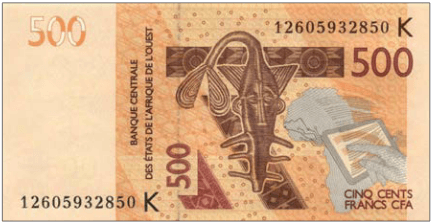
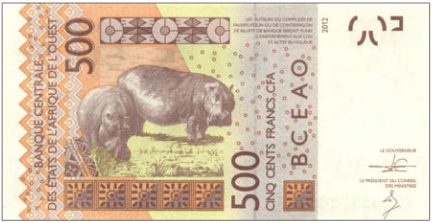
Orange, brown, and green. Front: French text; denomination as registration device; sawfish figurine; map of Africa; electronic circuits; hand touching screen on tablet. Back: French text; two hippopotamuses (Hippopotamus Amphibius) standing in grassland; penal code. 1-mm wide solid security thread with printed UMOA 500. Watermark: Sawfish and electrotype 500. Printer: (François-Charles Oberthur Fiduciaire). 114 x 60 mm. Paper.
Description: 1,000.00 XOF – West African Franc Size: 125 x 65 mm
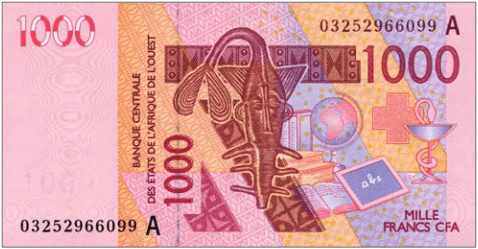
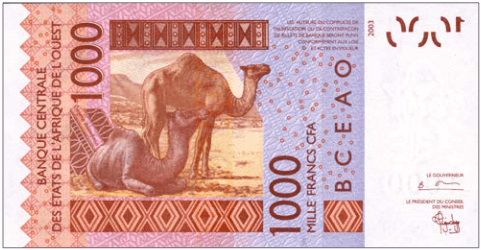
Pink, orange, brown, and purple. Front: French text; denomination as registration device; sawfish figurine; textbooks; globe centered on map of Africa; chalk slate; red cross; Bowl of Hygieia, a symbol of pharmacy (snake entwined around stem of chalice). Back: French text; two camels (Camelus dromedarius), one kneeling and one standing in desert in Sahel, Burkina Faso; penal code. 1-mm wide solid security thread with printed UMOA 1000. Watermark: Sawfish and electrotype 1000. Printer: (François-Charles Oberthur Fiduciaire). 125 x 65 mm. Paper.
Description: 2,000.00 XOF – West African Franc Size: 130 x 65 mm
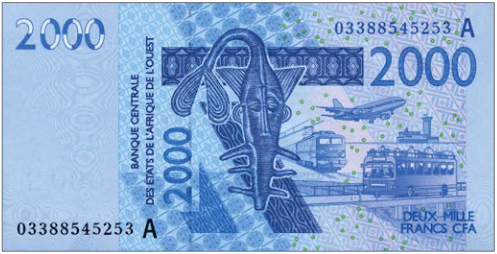
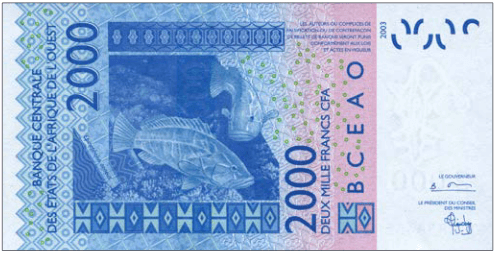
Blue, purple, green, and pink. Front: French text; denomination as registration device; sawfish figurine; electric railroad train; modern jet airliner ascending over airport control tower; passenger bus crossing automobile bridge. Back: French text; two white grouper fish (Epinephelus aeneus) swimming among corals; penal code. 1-mm wide solid security thread with printed UMOA 2000. Watermark: Sawfish and electrotype 2000. Printer: (François-Charles Oberthur Fiduciaire). 130 x 65 mm. Paper.
Description: 5,000.00 XOF – West African Franc Size: 141 x 74 mm
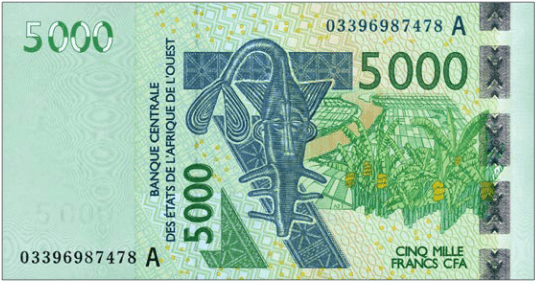
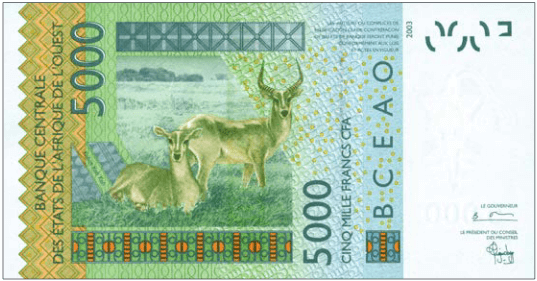
Green, blue, yellow, brown, and orange. Front: French text; denomination as registration device; sawfish figurine; aerial view of irrigated rice fields; banana trees. Back: French text; two Buffon’s Kob antelopes (Kobus Kob Kob), one kneeling and one standing in savanna; penal code. 8-mm wide windowed holographic stripe with sawfish, BCEAO and 5000. 1-mm wide solid security thread with printed UMOA 5000. Watermark: Sawfish and electrotype 5000. Printer: (François-Charles Oberthur Fiduciaire). 141 x 74 mm. Paper.
Description: 10,000.00 XOF – West African Franc Size: 146 x 74 mm
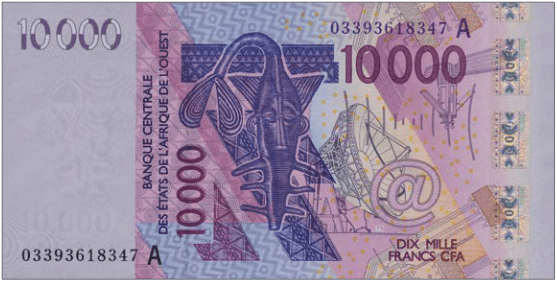
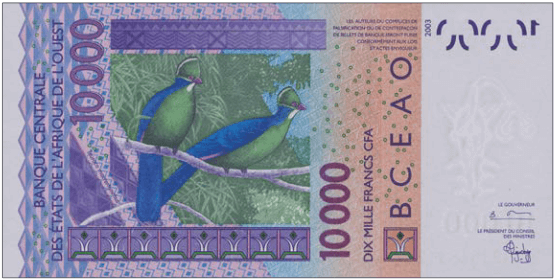
Purple, violet, blue, green, and orange. Front: French text; denomination as registration device; sawfish figurine; parabola (radio antenna); large @ (symbolizing Internet age); printed circuits; communications satellite in orbit. Back: French text; two yellow-billed turaco birds (Tauraco macrorhynchus) perched on a branch; penal code. 8-mm wide windowed holographic stripe with sawfish, BCEAO and 10000. 1-mm wide solid security thread with printed UMOA 10000. Watermark: Sawfish and electrotype 10000. Printer: (François-Charles Oberthur Fiduciaire). 146 x 74 mm. Paper.
Country Codes
With the exception of the first series issued in 1959, a letter on the front of each note uniquely identifies the country of issue, though the notes circulated throughout the West African franc zone. Take care not to confuse the series letter for the country code, the position of which changed with each new note family.
Beginning in 1991, the first two digits of the serial number represent the last two digits of the year of introduction. Beginning in 2003, the third and fourth digits of the serial number represent a 2-digit numeric code that also corresponds to the country of issue.
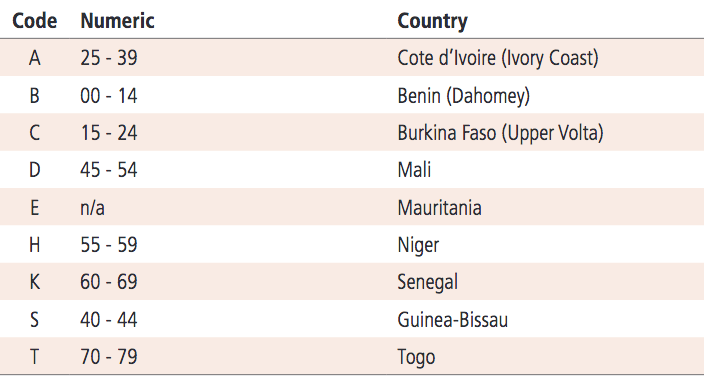
Central Bank of the West African States
Banque Centrale des États de l’Afrique de l’Ouest
The Banque Centrale des Etats de l’Afrique de l’Ouest (French: Central Bank of the West African States, BCEAO) was established 4 April 1959 by the government of France to provide a continuing emissions authority for West African colonies soon to become independent. The BCEAO succeeded the Institut d’Emission de l’Afrique-Occidentale Française et du Togo which had taken over emissions responsibility from the Banque de l’Afrique Occidentale in 1955. The Banque de l’Afrique Occidentale had held responsibility for monetary emission in the area since 1903, when it succeeded the Banque du Senegal.
The BCEAO was intended to operate under the umbrella of the French-African Community (Communaute Franco-Africaine) which accompanied the formation of the Fifth French Republic in 1958. Several West African members, however, declined to ratify the community arrangement. Subsequent bilateral and multilateral agreements were negotiated which led in 1962 to the formation of the West African Monetary Union (UMOA). Of necessity, the BCEAO functioned as a de facto emissions authority from 1959 until 1962. Since 1962 it has operated as a public multilateral entity under the UMOA. Its charter was revised in 1973 to provide greater African control over bank operations. Member countries are Benin, Burkina Faso, Cote d’Ivoire, Guinea-Bissau, Mali, Niger, Senegal, and Togo. Mauritania was a member until 1972; Mali left the BCEAO in 1962 but rejoined in 1984. Guinea-Bissau joined in 1997. Guinea, which was part of the original French West Africa colonial grouping, opted out of the economic union from the outset.
For more information, visit www.bceao.int.
Extras
According to an article on SeneDirect dated 1 April 2016, the Banque Centrale des Etats de l’Afrique de l’Ouest (BCEAO) plans to introduce a new 50,000-franc note on 30 April 2016. The new denomination is orange. The front of the note is inspired by information and communication technologies, illustrated by a touch pad. The back of the note depicts a pride of lions on the savannah.
